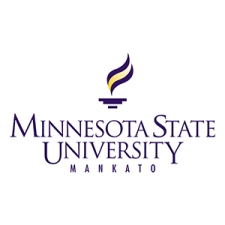
228 Wiecking Center
Mankato, MN 56001
United States
Associate Degree
Bachelor's Degree
Graduate (Certificates and Degrees)
About
Your big ideas can become a reality at Minnesota State Mankato, where you will find comprehensive support services, a wide variety of majors to explore, and opportunities to excel in and out of the classroom. Approximately 85 miles southwest of the Twins Cities of Minneapolis and St. Paul, the Greater Mankato area has a population of 103,566. Minnesota State Mankato enrolls over 14,000 students, including over 1,300 international students from 100+ countries. We offer more than 100 undergraduate areas of study and over 75 graduate areas of study to feed your big ideas.
Cost
Living On-Campus
22,529
Living Off-Campus
20,559
Living with Family
15,103
Average Net Price
$16,809 / year
This is the average annual amount that first-time, full-time undergraduate students pay at this institution after subtracting all grants and scholarships from the cost of attendance.
Show Net Price details
Net cost after grants and scholarships by income
$0-$30,000:
$12,115
$30,001-$48,000:
$12,389
$48,001-$75,000:
$14,810
$75,001-$110,000:
$18,896
Over $110,000:
$21,186
This net price data shows the average amount students have paid, according to their family income, after subtracting all grants and scholarships.
College Profile
Student/Faculty Ratio
21:1
Size of Student Body
14,574
Graduate Students Enrolled
1,956
Show Undergraduate Student Body details
Breakdown by Race
Black or African American:
6%
Hispanic:
6%
Asian:
3%
White:
71%
Two or more races:
3%
International Students:
9%
Unknown:
1%
Breakdown by Age
19 and Younger:
36%
20 to 24:
51%
25 to 34:
8%
35 to 44:
3%
45 and Older:
1%
Breakdown by Gender
Men:
45%
Women:
54%
New entering students who are transfers
28%
Student Success
Graduation Rate for Four-Year Programs
52%
Show Graduation Rate 4-yr Institution details
Completers within 6 years by race
American Indian or Alaska Native:
29%
Black or African American:
40%
Hispanic:
39%
Asian:
44%
White:
55%
Two or more races:
40%
Unknown:
39%
Completers within 6 years by gender
Men:
51%
Women:
53%
Retention Rate
77%
Show Retention Rate details
Retention Rate By Type
Full-time:
76%
Part-time:
56%
Campus Settings
Financial Aid
Average amount of federal, state, local, institutional or other sources of grant aid awarded to undergraduate students
$7,300
The following information pertains to first-time full-time undergraduate students.
Show Financial Aid details
Average amount of aid awarded to full-time first-time undergraduates
State/Local grant aid:
$3,215
Institutional grant aid:
$3,263
Federal grant aid:
$1,841
Average amount of grant aid awarded by income (all sources)
$0-$30,000:
$9,709
$30,001-$48,000:
$9,435
$48,001-$75,000:
$7,014
$75,001-$110,000:
$2,928
Over $110,000:
$638
School Scholarships
Yes
Financial Aid Contact
Cumulative Debt
This section shows the median debt graduates incurred to complete their degree at this institution.
Median Cumulative Debt by Degree Type
- Associate's Degree: $18,725
- Bachelor's Degree: $25,500
- Graduate Certificate: $25,385
- Master's Degree: $32,831
Percent of Graduates With Loans
- Associate's Degree: 71%
- Bachelor's Degree: 66%
- Graduate Certificate: 34%
- Master's Degree: 57%
- Doctorate: 44%
Admission Information
Application Fee
$20
- System applications (online)
- System applications (paper)
- School applications (online)
- School applications (paper)
- ACT or SAT
- High School Diploma or GED
- Transcripts
- Letters of recommendation, personal statement and updated senior year transcripts may be requested, if needed.
- Accepts dual credits
- Accepts exam-based credits
- Institution awards credits for military training
Application Timelines
Rolling Admissions Deadline
Five business days prior to the start of the semester.
Financial Aid Application Deadline
Varies by department.
Regular Decision Deadline
Five business days prior to the start of the semester.
Admissions Contact
Graduate Employment Outcomes
The data displayed below comes from the Graduate Employment Outcomes tool and only reports on graduates employed in Minnesota. This section shows employment data for graduate class of 2020, including percent of graduates with full-time employment in the 3rd year after college graduation and the median annual wages by award level, according to the Minnesota unemployment insurance records. Data does not include federal employees, self-employed (e.g. professional freelancers, artists, developers, designers, business owners), military, or individuals who moved out of state for a job. The list below may be incomplete and limited to some majors. Additionally, data has been suppressed when it refers to 10 or less students.Jump to:
This profile features institution-wide data. Be aware that some categories may not be showing and that data is suppressed when reporting is for 10 or less students. Most data and terminology is sourced from IPEDS. To learn more about each section, please refer to Data Sources.
The College Search Tool provides information and reported data for postsecondary institutions in Minnesota that receive federal and state financial aid. For licensed occupational training providers in Minnesota, please visit OHE's Licensed Career Schools.

